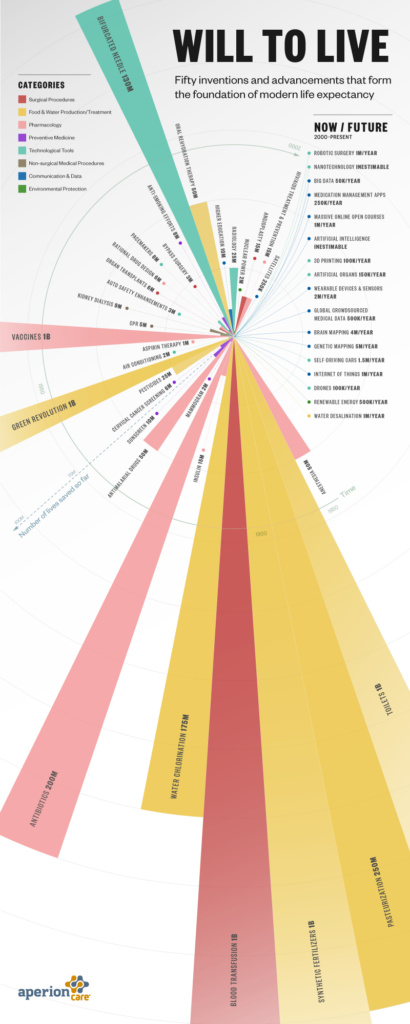Most people are familiar with historic life-saving inventions like penicillin and seat belts, but it’s difficult to place these things in the long history of human innovation and increased life expectancy. We reviewed research from every field of study and assembled a collection of 50 inventions that have had (or will have) the most definite and dramatic impact on human life expectancy.


The first boom of innovation followed the Industrial Revolution and spanned a strong half-century of legendary invention. The men and women who were pioneers in their fields at this time are responsible for saving literally billions of lives. In the pre-1900s, infection and contamination were among the biggest enemies of a long and healthy life. Major advancements in science and medicine for blood transfusions, pasteurization, antibiotics, and toilets meant that being able to clean, replace, sanitize, destroy, or flush away disease-riddled contaminates skyrocketed the mortality rate across the globe.
The development of synthetic fertilizers in 1909 cleared the way for the massive increase in plant growth and crop production in 1945, also known as the Green Revolution, which transformed the agriculture industry. Also by the mid-20th century, vaccines advanced enough to be made available to the mass public and severely cut down the mortality rate of several diseases, such as measles, tuberculosis, small pox, and rubella.
Instead of wide-sweeping innovations, the second half of the 20th century saw small yet significant steps in many directions, especially in technology tools. Between 1950-2000, inventions such as air conditioning, auto safety enhancements, radiology, pacemakers, and the bifurcated needle—which eliminated smallpox—are estimated to have saved approximately 171 million lives combined.
Some of the most exciting developments are happening in real time. The exponential growth in scientific fields like artificial intelligence and nanotechnology make estimating their positive effects nearly impossible. In other instances, advancements like genetic and brain mapping, self-driving cars, and desalination and renewable energy are still too new to be told but the benefit to human life behind these ideas is extremely promising. For these examples, “lives saved” is expressed as a speculative annual rate we might enjoy once a given technology is fully realized, in the near or distant future. It is simply too soon to tell.
It may be true that innovations of the past can end up hurting us in the present, such as with synthetic fertilizers helping accelerate the current level of environmental strain. However, we know that humans will never stop trying to improve the human experience. As long as there are barriers to having the best, healthiest, longest natural life possible, scientists, inventors, thinkers, and dreamers will continue to work towards breaking those barriers so that we humans can live our best lives.
Source:
Inventions that drive modern life expectancy. Aperion Care. (2018, February 27). https://aperioncare.com/blog/inventions-life-expectancy/.
Comment:
This was a very short, easy-to-read overview of most big inventions and interventions that have helped people live longer. It is cool to see such a broad and expansive view. Most of the interventions are medical and healthcare field related, which I think can in many ways relate back to aging and mobility. As designers, we aren’t making different vaccines and medications, but we can look into factors surrounding taking medication and how do people remember to take medicines or even get to the doctor’s office or pharmacy to get prescriptions. Even the article on voice recognition relates because of how voice recognition can give reminders to take medication. This expansive overview is helpful in giving a full overview of helpful inventions, and I can take these into consideration to pick something to hone into in finer detail.




